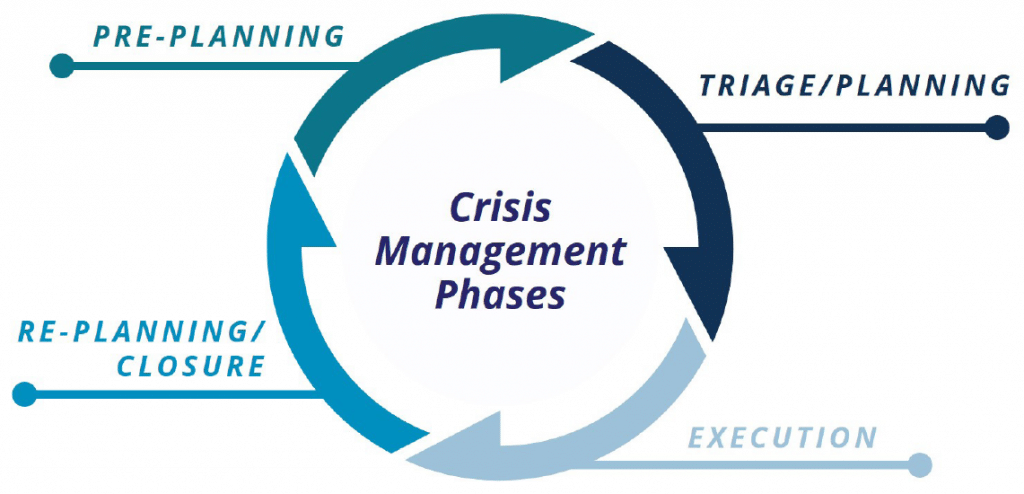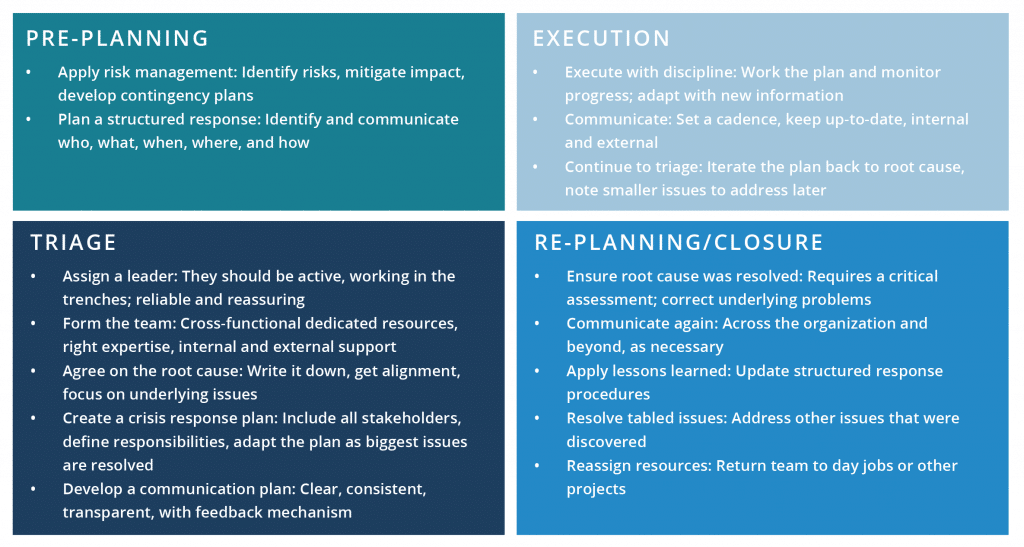Crisis management is an ongoing discipline
When you hear “crisis,” you think “COVID.” But a “crisis” event doesn’t need to be on the scale of a global pandemic to disrupt an organization and demand a quick response.
A crisis is any unplanned event that disrupts your business operation and poses a risk to your product’s safety, quality, or supply chain if it’s not addressed or resolved. It may come in the form of an FDA 483 or warning letter, product recall, plant audit, or sudden unavailability of a key component. It’s worth noting that, although we typically view a crisis to be an unexpected occurrence, unfortunately there are occasions where inaction or poor project execution causes a self-inflicted crisis-like scenario. For example, delaying the work to comply with a new regulation puts a company into crisis mode when the deadline looms and the necessary changes haven’t been implemented.
Regardless of cause or fault, a crisis can mean staff overload, loss of focus, delayed product launch, customer order shortages, and more. However, if managed correctly, a company can navigate through a crisis and learn from the experience, leading to improved processes, communication, and adaptability.
This piece examines the impacts a crisis can have on an organization and provides a framework for planning for potential crises, dealing with them if they occur, and learning from them to improve operations overall.
 What Could Go Wrong?
What Could Go Wrong?
A crisis affects an organization in multiple ways, and there are short- and long-term impacts.
OPERATIONAL. To address a crisis, a company will pull resources from their regular operational roles. Their functional work and assigned projects are now at risk. Often the resources pulled into a crisis are top performers who are likely involved in the most important projects for the company, thereby causing collateral damage.
FINANCIAL. A crisis can result in lost product sales, for instance, if you’re faced with a product recall or consent decree. There is an opportunity cost, as the organization focuses on the crisis and diverts resources from other key projects in the strategic portfolio. Fixing a problem during a crisis is more expensive, because time is of the essence and you don’t have the luxury of conducting thorough research to determine the optimal solution or negotiating with vendor partners to obtain the best price. As the organization throws money at the problem, the budget is cut elsewhere causing other negative business impacts. And in public companies or those looking for a buyer, crises can cause stock price or valuations to drop.
CULTURAL. When a company is in reactive crisis mode, it’s often disorganized and communications break down. This leads to confusion and fear throughout the organization. Consequently, stress can increase and morale decrease, leading to employee turnover. The impact of a one-time crisis is bad enough, but if a company regularly experiences crises, it will continually lose employees who value some level of work-life balance and stability.
REPUTATION. How you handle a crisis can affect working relationships with customers and potential customers, supply chain partners, investors, research and product development affiliates, and regulatory bodies. In addition, losing the trust of regulatory agencies may cause other products to undergo even greater scrutiny and extended approval times.
 Plan for the Unexpected—Before it Happens
Plan for the Unexpected—Before it Happens
Of course, the best way to handle a crisis is to prevent it. The next best way is to be prepared for how the organization will mobilize when a crisis arises.
APPLY RISK MANAGEMENT. First, learn to “see the future.” This doesn’t require a crystal ball. It requires a concerted, ongoing effort to monitor the market, regulatory landscape, key business metrics, and economic, political, and social trends. The more you can consider and anticipate, the better you’ll be at identifying potential risks and developing mitigation and contingency plans.
Risk management involves proactively identifying what-if scenarios (e.g., what if we can’t get a key raw material or there is a sudden demand spike? What if we lose a key customer?), evaluating the probability of occurrence and potential impact, and taking steps to eliminate or reduce the negative consequences. Scenario planning is a key tool in risk management, as it can help identify possible risks and solutions, and it encourages the team to look at potential situations from different angles. Keep in mind that risk can be associated with a positive outcome as well, such as an unexpected increase in demand. What if a drug was found to be an effective treatment for another disease?
Proactive risk management is not a one-time exercise. Monitoring and controlling risks are ongoing efforts that you should do at regular intervals, after any major milestone, changes to a key resource, or whenever a new risk is identified.
PLAN A STRUCTURED RESPONSE. Develop a structured response plan as part of your overall business continuity plan. This high-level plan addresses how to react if any type of crisis occurs. In a nutshell, a plan will identify the person or position that will lead the response, as well as requirements such as cross-functional support, time, funding, and other resources required. It should also consider who will support the work of those who are pulled to focus on the crisis.
The more specific the plan, the better. It can serve as both a starting point and communication plan for internal and external stakeholders. Organizations can develop structured response plans for any potential crisis event from a hurricane to a global pandemic that stalls overseas imports.
Like the risk assessment, update the structured response plan regularly and incorporate any lessons learned from past crises.
 Triage: Handling the Crisis Once it Occurs
Triage: Handling the Crisis Once it Occurs
Despite all your prevention and risk mitigation efforts, a crisis will eventually occur. When it does, the first step is to gather the right people and clearly define the problem.
ASSIGN THE LEADER. If you already have a structured response plan for this sort of crisis, engage the leader who was identified to own the problem and find a solution. If you don’t have a plan, now is the time to assign a leader. They must be a capable, dedicated, and consistent leader who can instill confidence and drive execution. It is best if the leader has experience managing in a crisis situation and is familiar with what it takes to keep the work on track and moving at an accelerated pace. They must be a strong communicator able to maintain team engagement and minimize distractions and interruptions from misaligned activities.
FORM THE TEAM. The leader will need a cross-functional team with clearly defined individual roles. Depending on the crisis, the team might include members from regulatory, quality, engineering, distribution, customer service, sales, marketing, and possibly other functions. Leverage internal resources who have the experience or specialized knowledge necessary to solve the problem, or consider outsourcing options to fill critical gaps. It is critical to ensure that each team member is dedicated to actively contribute to the effort. In an emergency, all their time should go toward developing the solution. Also, determine who will back-fill crisis team members’ roles while they focus on the crisis. You might need to bring in consultants or contractors to cover for those dedicated to the response to keep them from being distracted.
AGREE ON THE ROOT CAUSE. This sounds basic, but it’s important to write down the actual problem to be solved and get agreement from the team, management, and any other stakeholders. Try to reach the root cause rather than the symptom. For example, a 483 isn’t really the problem; it’s a document to help identify the problem.
CREATE A CRISIS RESPONSE PLAN. After you form the team and identify the root cause, it’s time to develop a response plan for resolving the crisis. The plan is a detailed roadmap that delineates the full scope of all that needs to be accomplished, when they need to be accomplished, and who is responsible. Be sure to involve all stakeholders and consider impacts to regular operations and the company culture.
Just as scenario planning is an effective tool in pre-planning, it can also be used once the crisis occurs. There will be several unknowns; rather than waiting for all the data to become available, you can map out plans based on different possibilities. For example, if you can no longer get a certain raw material for your top-selling product, you can develop specific plans for finding and qualifying a new supplier for the same material, as well as plans for replacing the material with a similar one. Working through the different scenarios and their risk factors takes time, but it helps identify and quantify solutions.
When creating the response plan, aim to tackle the most urgent problems first. This is the key to triage. Even if you know the root cause, there might be more immediate issues to solve first to stabilize the situation.
Imagine the supplier of a material for your top-selling product has informs you they will not be able to meet your supply needs next month. First you need to gauge the impact by determining how much inventory you have on hand and how long the product will be unavailable. You’ll also need to explore the cause with the supplier. Are they simply too busy, or are they having some other manufacturing or supply issue? This will inform the approach you take with the supplier and determine your path forward.
Importantly, recognize that decisions must be made quickly, and that the plan will likely have to be adjusted as necessary as new information becomes available.
DEVELOP A COMMUNICATION PLAN. As soon as possible, and at a regular cadence, communicate plans to any affected stakeholders. Convey the proper sense of urgency as well as empathy. Messaging should be transparent to build and maintain trust. It’s OK to talk about what you don’t know, but be sure to communicate that you’re working on getting the answers and when you will get back with the answer or an update. Also make sure to share successes when you experience them.
To be truly effective, communication needs to be bidirectional. Enable and encourage questions and feedback, and respond to them. Again, if you don’t have an answer now, let them know. And don’t neglect to respond when you do have the answer.
SCROLL DOWN: Silver Linings of Dealing with a Crisis [Full article continues below] →
 What Could Go Wrong?
What Could Go Wrong? Plan for the Unexpected—Before it Happens
Plan for the Unexpected—Before it Happens Triage: Handling the Crisis Once it Occurs
Triage: Handling the Crisis Once it Occurs Execution: Work the Plan
Execution: Work the Plan Closure and Re-Planning
Closure and Re-Planning This is Not the End
This is Not the End
